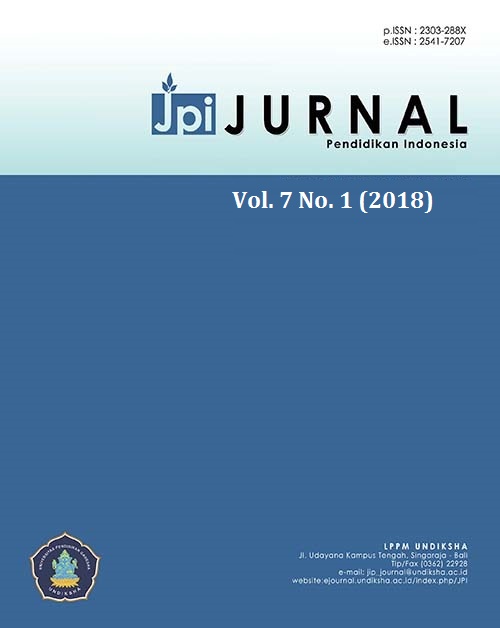Exploring Culture in Indonesia English Textbook For Secondary Education
DOI:
https://doi.org/10.23887/jpi-undiksha.v7i1.13692Keywords:
Culture, English, Textbook.Abstract
The curriculum in schools is always changing. There are new advancements that are being made and new components being incorporated into the curriculum. Culture and identity have become a rising issue in some schools nowadays and it has slowly begun to show its importance to the curriculum. Hence, it also has become a rich source of investigation which inseparable in the field of English Language Teaching. With this background, this study investigates the representation of culture-related contents embodied in Indonesian middle school English electronic textbook 2013 curriculum. The present study explores how culture is preserved and disseminated in the textbooks. It is descriptive qualitative in nature. The data were taken from Electronic English Textbook for VII grade entitled “When English Rings a Bell” (2014) by Kemdikbud RI, are in the form of written texts and illustrations that may accompany the reading passages. The five dimensions of culture were adopted in this study proposed by Moran (2001) which cover the products, practices, perspectives, persons and communities. The result shows that Indonesia cultural aspect chosen selectively to be included in this national textbook to enhance both teachers’ and students’ awareness for the interdependent relationship between language and culture.
References
Altbach, P.G. (1991). Textbooks in American Society: Politics, Policy, and Pedagogy. Buffalo: SUNY Press.
Badan Standar Nasional Pendidikan (BSNP). (2006). Kurikulum dalam Konteks Standar Nasional Pendidikan.
Brown, H. Douglas. 2000. Principles of language learning and teaching (4th edition). White Plains, NY: Addison Wesley Longman.
Brown, Douglas H.. (2006). Priciples of Language Learning and Teaching-5th Edition. White Plains, NY: Addison Wesley Longman.
Buckingham, B.R. (1960). “Textbooks”, in Encyclopedi of Educational Research, Third Edition, (ed.) Chester W. Harris, (ass.) Marrie R. Liba, The MacMillan Company, New York.
Chambliss, M.J. dan R.C. Calfee, (1998). Textbooks for Learning: Nurturing Children’s Minds, Massachusetts: Blackwell Publishers.
Corbett, J. (2003). An intercultural approach to English language teaching. Clevedon: Multilingual Matters Ltd.
Cortazzi, M. & Jin, L. (1999). Cultural mirrors, materials and methods in the EFL classroom. In E. Hinkel (ed.), Culture In Second Language Teaching And Learning. Cambridge University Press.
Hermawan, Budi. (2012). Traces of cultures in English textbooks for primary education. Indonesian Journal Of Applied Linguistics, 1(2).
Hinkel, Eli. 1999. Culture in second language teaching and learning. Cambridge: Cambridge University Press.
Kalmus, V. 2004. What do pupils and textbooks do with each other? Methodological problems of research on socialization through educational media. Journal of Curriculum Studies [online]. (13 Oct 2016) http://pdfserve.informaworld.com/128185_731193618_713741682.pdf.
Karvonen, P. 1995. http://pdfserve.informaworld.com/128185_731193618_713741682.pdf. Retrieved on on 14 January 2017.
Kramsch, C. (1993). Context and culture in language teaching. Oxford: Oxford University Press.
Lähdesmäki, S. 2004. Oppikirja tutkijan käsissä. In T. Nevalainen, M. Rissanen and I. Taavitsainen (eds.): WSOY, 271–284.
Locked, M. dan A. Verspoor. 1990. Improving Primary Education in Developing Countries: A Review of Policy Options. Washington DC: World Bank.
Luukka, M., S. Pöyhönen, A. Huhta, P. Taalas, M. Tarnanen and A. Keränen. (2008). Retrieved on 13 January 2017.
Mckay, S. L. (2003). Toward an appropriate EIL pedagogy: re-examining ELT assumptions. International Journal of Applied Linguistic, 13(1).
Moran, Patrick R. and Ziwen Lu. 2001. Teaching culture: Perspectives in practice. Boston, MA: Heinle & Heinle.
Patrick, J.J. 1998. High School Government Textbooks. Eric Digest, Ed 301532, December.
Pusat Perbukuan. 2005. Peraturan Menteri Pendidikan Nasional Nomor 11 Tahun 2005 tentang Buku Teks Pelajaran. Jakarta: Departemen Pendidikan Nasional.
Pusat Perbukuan. 2005. Peraturan Menteri Pendidikan Nasional Nomor 19 Tahun 2005 tentang Buku Teks Pelajaran. Jakarta: Departemen Pendidikan Nasional.
Pusat Perbukuan. 2005. Peraturan Menteri Pendidikan Nasional Nomor 2 Tahun 2008 tentang Buku. Jakarta: Departemen Pendidikan Nasional.
Pusat Kurikulum dan Perbukuan Badan Penelitian dan Pengembangan Kementerian Pendidikan Nasional Indonesia. http://puskurbuk.net/web13/bse.html (diakses pada 2 Nopember 2013)
Risager, K. 1991. Cultural references in European textbooks: An evaluation of recent tendencies. In D. Buttjes and M. Byram (eds), Mediating languages and cultures. Clevedon: Multilingual Matters, 181-192.
Sugirin, Sudartini, Suciati, and Nurhayati. (2011). A study on cultural integration in the English textbooks for junior high schools. LITERA, 10(2), 235-246.
Tucker, C. Allen. 1978. Evaluating Beginning Textbooks. Dalam Madsen and Bowen. 1978. Adaptation in Language Teaching. Massachussett: Newbury House Publisher Inc.
Downloads
Published
Issue
Section
License
Authors who publish with the Jurnal Pendidikan Indnesia agree to the following terms:
- Authors retain copyright and grant the journal the right of first publication with the work simultaneously licensed under a Creative Commons Attribution License (CC BY-SA 4.0) that allows others to share the work with an acknowledgment of the work's authorship and initial publication in this journal.
- Authors are able to enter into separate, additional contractual arrangements for the non-exclusive distribution of the journal's published version of the work (e.g., post it to an institutional repository or publish it in a book), with an acknowledgment of its initial publication in this journal.
- Authors are permitted and encouraged to post their work online (e.g., in institutional repositories or on their website) prior to and during the submission process, as it can lead to productive exchanges, as well as earlier and greater citation of published work. (See The Effect of Open Access)








